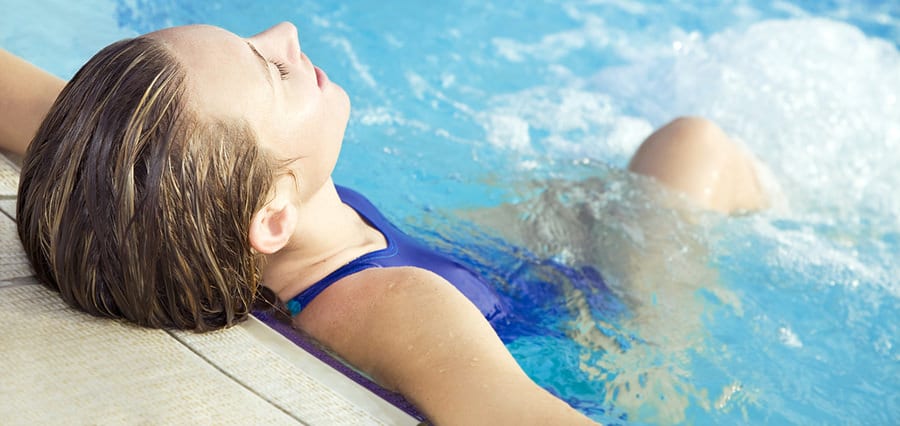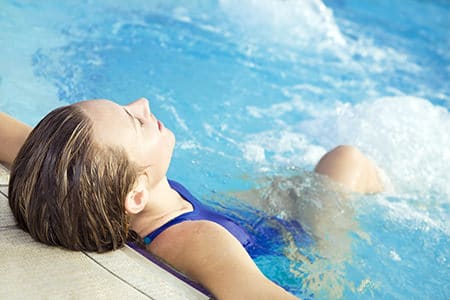
Sometimes too much of a good thing can, in fact, be bad for you. I was wondering if this principle applied to luxuriating in my hot tub and I started to wonder how long it was safe or advisable to stay in a hot tub to get the most benefit but without risking any health issues. I decided to do some research and here is what I discovered.
So, how long is it safe to sit in a hot tub? A good recommendation is between 15 and 30 minutes in your hot tub. As an absolute maximum 45 minutes to 60 minutes is recommended. Anything over an hour is considered risky.
However, there are a number of variable factors to be taken into consideration. Some people could be at serious risk by spending too long in their hot tub and be putting their body under unnecessary strain without even realizing it.
Personalize Your Hot Tub Timing
So, the guidelines above are a good general starting point. Things will change though depending on a number of variable factors.
- The outside air temperature. If it’s really cold outside your body will probably cool more quickly (especially if you are not fully submerged) and you will be able to comfortably stay longer in the hot tub. Similarly, on a really hot day, you may overheat much more quickly. You may well be even overheating or dehydrated when you get into the hot tub with can make things worse.
- Your physical health. If you are in good physical shape then you can, most probably, safely stay in the hot tub for the recommended period of time without any issues. However, if you have a heart condition, blood pressure issues or are pregnant it can be a good idea to avoid hot tubs, reduce the temperature/time you are in the hot tub or at the very least get the advice of your doctor. Children are also less good at regulating their temperatures so should be in the hot tub for less time than recommended for adults.
- Your physical makeup. Apparently, women can withstand heat more comfortably than men. This is to do with body and muscle mass – it would stand to reason that more petit people would have a different reaction to extreme heat than larger people? I’m not basing this on fact but it seems like a reasonable assumption to make.
- How deep you go into the water. Think about it. If you are totally immersed right up to your neck then there is less exposed body area for the heat to escape. Your face is probably in a cloud of steam as well adding to the heat build up. If you are only waist deep then there is plenty of exposed skin area around your vital core and organs to help dissipate the accumulating heat.
- Water temperature. Ok, this is obvious! But, if you are wanting to extend the amount of time that you can safely and comfortably stay in the hot tub then reducing the temperature a little will make a big difference! Most people like the water somewhere between 36 degrees C and 39 degrees C with 40 degrees C being the absolute maximum.
So,being aware of the time you are in the hot tub is vital. If you need an attractive visual cue to help you with this then this Sauna Hourglass Sand Timer could be just what you are looking for!
What happens to your body when you are in the hot tub?
When your body temperature rises small blood vessels beneath the skin rapidly dilate. You are probably familiar with how some people go red when they are hot. This can cause a sudden drop in blood pressure and the heart has to pump harder to compensate for this and to keep the circulation going.
As you remain longer in the hot water, assuming that it’s hotter than your body’s core temperature, the heat will gradually transfer and your core temperature will increase. Bear in mind that your body will struggle to regulate it’s temperature as you are submerged in water and sweating won’t work! Making sure you are out of the sun in shade can help and be more comfortable. If you need some ideas for sun shades have a look at my sunshade page here!
Now that’s not to say that all of this heat is a bad thing! The warmth is lovely and relaxing, being in the hot tub is said to actually help lower blood pressure, the lower blood pressure can relieve headaches and migraines. Obviously, it puts you in a good mood, it’s de-stressing and can help you sleep better. You can even burn off as many calories as going for a short walk if you get a good sweat on!
This is all well and good but how do you know when you have had enough?
What are the symptoms of staying in the hot tub for too long?
- Your heart is going ten to the dozen to compensate for the blood pressure drop. You might just feel it pumping away or you could feel slightly breathless.
- Burning sensation on the skin. If your hot tub is at the correct temperature this shouldn’t be an issue but, if you have sensitive or broken skin, you could be at risk of skin irritation. In a similar way to being out in the sun for too long if it feels irritating at the time it will be far worse later on.
- Lightheaded or dizziness. Again this is related to the blood pressure issue. Be particularly careful getting out of your hot tub as, when you hit the cooler air, you will be at risk of losing your balance and falling or slipping over.
- Overheating/dehydration. Obviously being thirsty is a symptom of early dehydration but, as the condition worsens dizziness, headache, nausea, confusion, agitation, loss of energy, irritability and even the possibly unconsciousness can follow.
- Nausea and vomiting. Apart from being a symptom of dehydration some people feel nausea and vomit if they overheat or stay in the hot tub for too long. There is possibly a link to eating just before or actually in the hot tub. Probably best to avoid it just in case!
That’s all very interesting but, just to lighten the mood…..
Why does my skin go all wrinkly in water?
This is where you suddenly realize that your body is amazing! Apparently, rather than it being an involuntary puffing up of the skin, your skin goes wrinkly to improve your grip! Obviously, it’s just your hands and feet so, when your skin is wet the wrinkles help you to pick up wet objects and to grip as you walk – ingenious!
Do hot tub chemicals damage my skin?
If you are using chlorine in your hot tub it can potentially cause skin irritation. It’s also irritating to the eyes and lungs as well. One of the main symptoms is dry skin, in more severe cases this can develop into a rash as well. Chlorine is also not great if it comes into contact with an already present skin condition such as eczema.
You can minimize the problem by making sure that you check that you have the correct chemicals in your hot tub on a regular basis. It’s also a good idea to have a shower when you get out of the hot tub to cleans the skin. Moisturizing and applying vitamin C cream can also help.
Can hot tubs make you ill?
Hot tubs are warm and damp places and, if not properly cleaned and disinfected, bacteria will spread quickly. You are also likely to be in close proximity to other people who might cough and sneeze their germs into the lovely warm atmosphere ready for you to breath in.
Cleanliness is the key. Check the hot tub chemicals regularly and keep up with the maintenance schedule. It can also be helpful if people shower before going into the hot tub as well. Our bodies harbor a great deal of sweat and other secretions that will all end up in the hot tub if you are not careful.
Related Questions
Does a hot tub damage my swimming costume/bathing suit? In a word yes. Hot tubs aren’t particularly good for swimming costumes. If possible rinse out your bathing suit/swimming costume after using it in the hot tub by hand in cold water with a little washing liquid and hang out to dry. If you hot tub frequently it can be a good idea to have a dedicated, not so posh, bathing suite just dedicated to using in the hot tub.
Should I use the hot tub if I feel ill or have a temperature? You could take the view that if you have a mild fever or temperature then you should “sweat it out” as your body is raising it’s temperature to basically kill whatever is causing the infection. However, the most sensible advice is to avoid getting in the hot tub unless you feel perfectly well.


Comments
It’s really good that you mentioned that staying in excess of an hour in a hot tub is already too risky and that it’s best to soak in between 30 to 45 minutes for best results. My grandparents might need to take note of this because they not only tend to lose track of time in the tub, but they also tend to fall asleep in the hot warm water. Since the hot water deeply relaxes their arthritis and muscle pains, they’d often soak themselves in the hot tub for hours without worries of getting burned or catching colds when they surface.